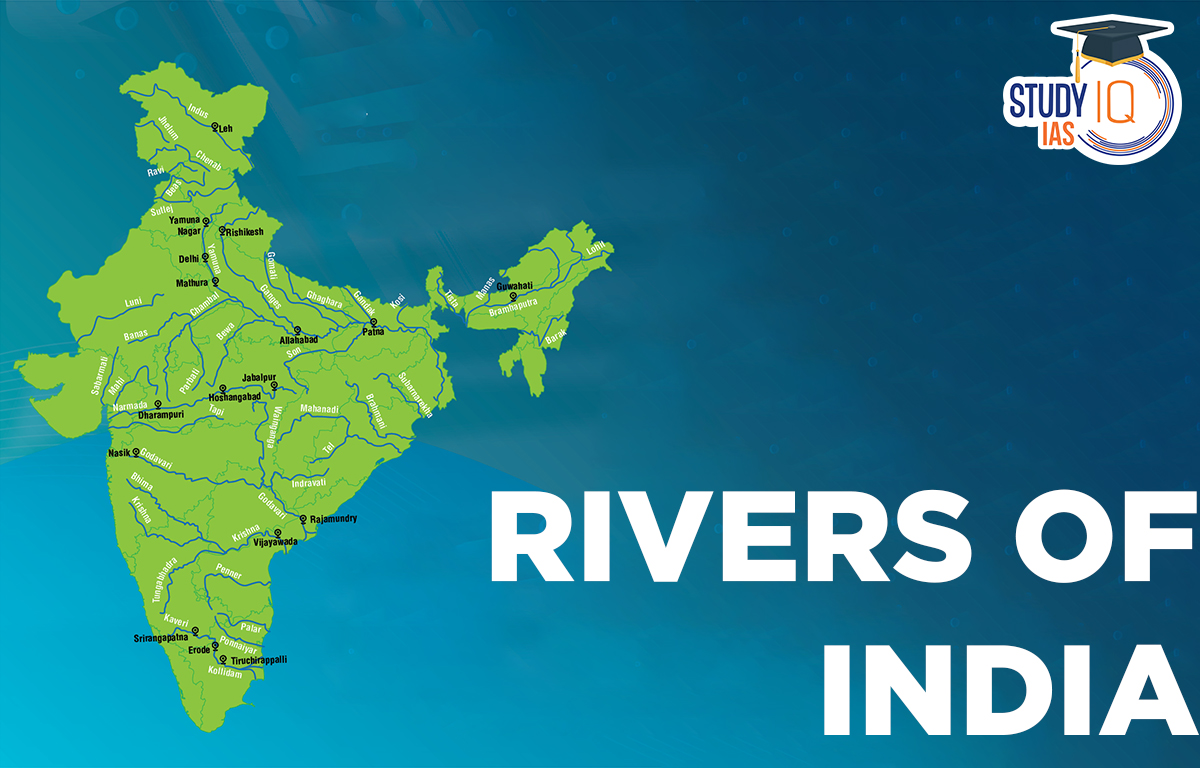Table of Contents
India, a land of diverse geographical features and rich cultural heritage is blessed with numerous rivers that are crucial to its ecology, economy, and society. These rivers have played an integral role throughout history by shaping civilizations, providing sustenance, and fostering trade and transportation. The river systems in India are categorized into two primary groups: Himalayan Rivers and Peninsular Rivers. This article delves into some of the most important rivers, starting with the Ganga and ending with the Godavari, highlighting their origin, course, tributaries, and significance.
Rivers of India
The Indian rivers significantly impact the lives of the Indian people. In addition to providing energy, affordable transportation, irrigation, and drinking water, the nation’s river systems also support many people’s livelihoods. This explains why almost every major city in India is situated along a river.The Indian River System is made up of seven major rivers (the Indus, Brahmaputra, Narmada, Tapi, Godavari, Krishna, and Mahanadi) with a large number of tributaries.
The Bay of Bengal receives water from the majority of rivers. Some of the rivers that flow through the western region of the nation and eastward into the Himachal Pradesh state discharge into the Arabian Sea. Inland drainage can be found in sections of Ladakh, the northern Aravalli range, and the dry Thar Desert. One of the three primary watersheds serves as the source for all of India’s major rivers.
- The Himalayan and Karakoram mountain ranges
- Central India’s Vindhya and Satpura mountains, as well as the Chotanagpur plateau
- Western India’s Sahyadri or Western Ghats
List of Rivers of India
Here is the complete List of Rivers of India with :
| Rivers | Length | Origin | End |
| Indus | 2,900 | comes from the Tibetan plateau and enters India through J&K | Merges into the Arabian sea near Sindh |
| Brahmaputra | 2,900 | Arunachal Pradesh is where the Himalayan Glacier enters India from Tibet | Merges with Ganga and ends in the Bay of Bengal |
| Ganga | 2,510 | Uttarakhand’s Gangotri Glacier (Bhagirath) | Bay of Bengal |
| Godavari | 1,450 | begins in Maharashtra and travels across 7 states in India | Ends in the Bay of Bengal |
| Narmada | 1,290 | beginning in Amarkantak, Madhya Pradesh | Drains into the Arabian sea via the Gulf of Cambay |
| Krishna | 1,290 | originates in Maharashtra’s Western Ghats, close to Mahabaleshwar | Ends in the Bay of Bengal near Andhra Pradesh |
| Mahanadi | 890 | was originated in Dhamtri, Chhattisgarh | Ends in the Bay of Bengal in Odisha |
| Kaveri | 760 | Talakaveri in the Karnataka Western Ghats | Ends in the Bay of Bengal |
Indian River System in Detail
The Indian River System is an intricate network of rivers that plays a vital role in shaping the country’s geography, ecology, and culture. It is broadly classified into two main systems:
- Himalayan rivers
- Peninsular rivers
The Himalayan rivers, including the Ganga, Yamuna, and Brahmaputra, are snow-fed and flow throughout the year, often causing seasonal floods.
In contrast, the Peninsular rivers like the Godavari, Krishna, and Narmada are primarily rain-fed and experience more seasonal flow.
These rivers not only provide water for agriculture and livelihoods but also hold immense spiritual significance in Indian culture, with several being considered holy. As lifelines to millions of people, they support extensive ecosystems, contribute to the fertility of the land, and are central to India’s socio-economic fabric.
Himalayan Rivers of India
The Ganga, Indus, and Brahmaputra rivers systems are the main Himalayan river systems. Huge basins are created by the Himalayan Rivers. The Himalayas are traversed by several rivers. During the time of the Himalayan uplift, the river’s down-cutting created these deep valleys with sheer rock sides.
They carry massive loads of sand and silt up the streams while engaging in vigorous erosional activity. Large meanders and numerous depositional structures, including flood plains, river cliffs, and levees, are formed in the plains.
| Rivers | Length (KM) | Origin | End |
| Ganga | 2,525 | Gangotri Glacier (Bhagirathi), Uttarakhand | Bay of Bengal |
| Yamuna | 1,376 | Yamunotri Glacier, Uttarakhand | Merges with Ganga at Allahabad (Triveni Sangam – Kumbh Mela spot |
| Brahmaputra | 1,800 | Himalayan Glacier in Tibet, but enters India in Arunachal Pradesh | Merges with Ganga and ends in Bay of Bengal |
| Chambal | 960 | Tributary of Yamuna River, starting at Madhya Pradesh | Joins Yamuna River in UP |
| Son | 784 | Tributary of Ganga, starting at Amarkantak, Madhya Pradesh | Joins Ganga just above Patna – also considered part of the Vindhya river system |
| Gandak | 630 | Nepal; Ganges tributary at Indo-Nepal border (Triveni Sangam) | Joins Ganga near Patna |
| Kosi | 720 | Starts from Bihar near Indo-Nepal border | Joins Ganga near Katihar district of Bihar |
| Betwa | 590 | Tributary of Yamuna, rises at Vindhya region, MP | Joins Yamuna at Hamirpur in UP |
| Gomti | 900 | Tributary of Ganga, starting at Gomat Taal, UP | Joins Ganga in Varanasi district |
| Ghaghra | 1080 | Himalayan Glacier in tibet, tributary of Ganga | Joins Ganga in Bihar |
| Hugli (Hooghly) | 260 | Tributary of Ganga near West Bengal | Merges with Ganga at the Bay of Bengal |
| Damodar | 592 | Tributary of Hugli near Chandwar, Jharkhand | Merges with Hugli in West Bengal |
The Indus River
The Indus has its beginnings in the northern Kailash range in Tibet, close to Lake Manasarovar. Through Tibet, it travels in a northwesterly direction. In Jammu and Kashmir, it crosses into Indian territory. In this area, it creates an attractive gorge. In the Kashmir region, it is joined by the Zaskar, the Shyok, the Nubra, and the Hunza. Jhelum, Chenab, Ravi, Beas, and Sutlej are the principal Indus River tributaries in India.
1. Jhelum
The Jhelum begins in a spring near Verinag, which is located in the southernmost region of Kashmir. After entering the northward-facing Wular Lake, it subsequently empties into Baramula. It enters a deep gorge created by the river in the Pir Panjal Mountain between Baramula and Muzaffarabad.
2. Chenab
The confluence of two rivers, the Chandra and the Bhaga, which come from opposite sides of the Bara Lacha Pass in Lahul, gives rise to the Chenab. In Himachal Pradesh, it is also known as the Chandrabhaga.
3. Ravi
The Ravi has its beginnings close to the Rohtang pass in the Kangra Himalayas and travels in a northwestern direction. When it enters the Punjab plain at Madhopur, it cuts a gorge in the Dhaola Dhar Mountain before turning southwest around Dalhousie.
4. Beas
Beas Kund, which is close to the Rohtang pass, is where the Beas begins. It passes through Manali and Kulu, where its lovely valley is referred to as the Kulu valley.
5. Sutlej
The Rakas Lake in Tibet, which has a stream connecting it to the Manasarovar Lake, is where the Sutlej starts. It enters Himachal Pradesh at the Shipki Pass, where it joins the Spiti river, flowing north-westerly.
| Rivers | Length (KM) | Origin | End |
| Indus | 3180 | Comes from the Tibetan plateau and enters India through J&K | Merges with the Arabian Sea close to Sindh |
| Chenab | 960 | Upper Himalayas in the Spiti district of Himachal Pradesh | Combine with Indus |
| Jhelum | 725 | Punjab’s Chenub River tributary | merges at Jhang with Chenab (Pakistan) |
| Ravi | 720 | Begins in the Himachal Pradesh district of Kangra at Bara Bhangal. | Merge Chenab in Pakistan |
| Sutlej | 1500 | Indus River tributary with origins in Tibet’s Rakshastal | Ends at the Arabian Sea and meets the Beas River in Pakistan. |
| Beas | 470 | It rises in the Himalayas in central Himachal Pradesh | Merges in Sutlej river in Punjab, India |
The Brahmaputra River
The Mansarovar Lake, which is also the source of the Indus and the Satluj, is where the Brahmaputra originates. The majority of its course is outside of India; however, it is significantly longer than the Indus. It moves parallel to the Himalayas, flowing eastward.
After passing Namcha Barwa (7757 m), it makes a U-turn to enter Arunachal Pradesh, India, where it is called as Dihang. This river undercuts by a distance of about 5500 meters. Several tributaries join it as it runs through Arunachal Pradesh and Assam in India.
Peninsular Rivers of India
The Narmada, Tapi, Godavari, Krishna, Kaveri, and Mahanadi river systems are among the major peninsular river systems. The Peninsular Rivers traverse modest valleys. Since their flow depends on rainfall, many of them are seasonal. Because of the softer slope, erosional activity is also relatively modest in intensity. There isn’t much room for meandering because of the firm granite bed and lack of sand and silt. As a result, many rivers follow straight, horizontal courses. There are numerous prospects for hydroelectric electricity along these rivers.
1. Mahanadi
A significant river in east-central India is the Mahanadi. It begins in Chhattisgarh’s Sihava Mountains and runs primarily through the state of Orissa (Odisha). Compared to other rivers in the Indian subcontinent, this river deposits the most silt. Sambalpur, Cuttack, and Banki are cities where the Mahanadi flows
2. Godavari
After the Ganga, the Godavari River has the second-longest course in India. The river rises in Maharashtra in Triambakeshwar, and it eventually runs through the states of Maharashtra, Chhattisgarh, Madhya Pradesh, Orissa (Odisha), Telangana, Andhra Pradesh, Karnataka, and Puducherry before emptying into the Bay of Bengal. The river is referred known as Dakshina Ganga because of its lengthy course.
3. Narmada River
A river in central India is called the Narmada or Nerbudda. It is 1,289 kilometres (801 miles) long and serves as North India’s and South India’s traditional borders.
4. Tapi River
Central India’s Tapi River is a river. With a length of about 724 km, it is one of the main rivers in peninsular India. Only the Tapi River, the Narmada River, and the Mahi River flow from east to west.
5. Krishna River
The Krishna is one of India’s longest rivers (about 1300 km in length). It starts in Maharashtra at Mahabaleswar, travels through Sangli, and ends in Andhra Pradesh at Hamasaladeevi, where it joins the sea in the Bay of Bengal.
6. Kaveri River
One of India’s main rivers, the Kaveri (sometimes called Cauvery or Kavery), is revered by the Hindus. Dakshin Ganga is another name for this river. It discharges into Bengal Bay.
Peninsular Rivers Flowing from East to West
| Rivers | Details |
| Luni | It originates from the western Aravalli Range near Ajmer, is sometimes known as the Sabarmati, and flows through Gujarat’s swampy Rann of Kutch. |
| Sabarmati | Begins at Dhebar Lake in the Aravalli Range of Udaipur (Rajasthan) It flows through an estuary to the Arabian Sea. |
| Mahi | Comes from the Vindhya range in MP and empties into the Gulf of Cambay |
| Narmada |
Important Facts:
|
| Tawa | The longest tributary of the Narmada rises in Betul, Madhya Pradesh’s Satpura Range. |
| Tapi |
|
| Periyar | Rises from Kerala’s Western Ghats, flows west, and empties into the Arabian Sea via an estuary. |
Peninsular Rivers Flowing from West to East
| Rivers | Details |
| Mahanadi | Flow routes include Chhattisgarh, Orissa, EGs, and BOB. The famous project is the Hirakund Dam. |
| Godavari |
|
| Penganga | It originates in the Ajanta Hills in Maharashtra and is a tributary of the River Wardha before joining the Godavari. |
| Krishna |
|
| Tungabhadra | One of Krishna’s main tributaries, rising from the Western Ghats |
| Bhima | Rises from the Balaghat range in Maharashtra and is a Krishna tributary |
| Kaveri |
|
| Penner |
|
| Vaigai |
|
Rivers of India Names with States
| S. No. | State | Rivers |
| 1 | Andhra Pradesh | Godavari & Musi |
| 2 | Bihar | Ganga |
| 3 | Delhi | Yamuna |
| 4 | Goa | Mandovi |
| 5 | Gujarat | Sabarmati |
| 6 | Haryana | Yamuna |
| 7 | Jharkhand | Damodar, Ganga & Subarnarekha |
| 8 | Karnataka | Bhadra, Tungabhadra,Cauvery, Tunga & Pennar |
| 9 | Kerala | Pamba |
| 10 | Madhya Pradesh | Betwa, Tapti, Wainganga, Khan, Narmada, Kshipra, Beehar, Chambal & Mandakini. |
| 11 | Mahrashtra | Krishna, Godavari, Tapi and Panchganga |
| 12 | Nagaland | Diphu & Dhansiri |
| 13 | Orissa | Brahmini & Mahanadi |
| 14 | Punjab | Satluj |
| 15 | Rajasthan | Chambal |
| 16 | Sikkim | Rani Chu |
| 17 | Tamil Nadu | Cauvery, Adyar, Cooum, Vennar, Vaigai & Tambarani |
| 18 | Uttar Pradesh | Yamuna, Ganga & Gomti |
| 19 | Uttranchal | Ganga |
| 20 | West Bengal | Ganga, Damodar & Mahananda |
Longest Rivers of India
| S. No. | River | Length in India (km) | Total Length (km) |
| 1. | Ganga | 2525 | 2525 |
| 2. | Godavari | 1464 | 1465 |
| 3. | Krishna | 1400 | 1400 |
| 4. | Yamuna | 1376 | 1376 |
| 5. | Narmada | 1312 | 1312 |
| 6. | Indus | 1114 | 3180 |
| 7. | Brahmaputra | 916 | 2900 |
| 8. | Mahanadi | 890 | 890 |
| 9. | Kaveri | 800 | 800 |
| 10. | Tapti | 724 | 724 |
Rivers of India Important Facts for UPSC
- The Hindu Triveni Sangam mythology of the confluence of the Ganga, Yamuna, and Saraswati rivers includes the River Saraswati, which was once thought to be a mythological river.
- According to recent investigations, the Saraswati River met the Ganga and Yamuna rivers at the site of the Kumbh Mela while flowing underground.
- The Meghna, a significant river in Bangladesh, empties into the Bay of Bengal and is a tributary of the Indian Brahmaputra river.


 Places in News for UPSC 2025 for Prelims...
Places in News for UPSC 2025 for Prelims...
 Evaporative Demand: Main Drivers and its...
Evaporative Demand: Main Drivers and its...
 Indus Valley Civilization, History, Phas...
Indus Valley Civilization, History, Phas...





















